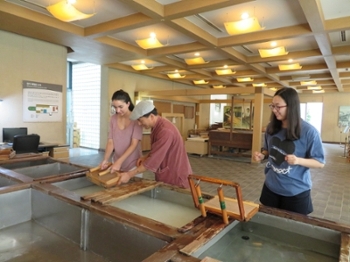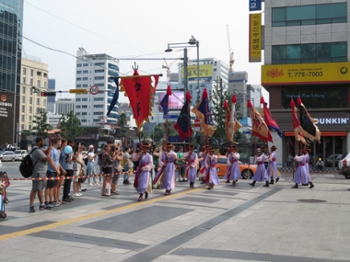Students engineer solutions abroad at KAIST workshop

This summer, Miami engineering students did incredible work while studying abroad in Korea.
The trip, which ran from June 26th to July 21st, was held at KAIST, a university commonly referred to as the Korean MIT. Twelve students participated in the workshop, led by professor Jeong-Hoi Koo of the mechanical and manufacturing engineering department. Nine were Miami students, and three were from KAIST.
The students split into three teams, with three very different objectives.
Utilizing appropriate technology for STEM education
In this project students developed learning activities for kids.The team, Paul Goetze, Ashley Guirl, Maddie Spurlock, and Hyungjin Choi, worked on translating appropriate technology into something kids could understand.
Appropriate technology is high-impact technology that is socially and economically appropriate for the community it is applied to. Dr. Koo has worked with student groups in the past who have developed lightweight, low-cost generators for rural communities, and these students used a modified version of this technology as a learning tool.
There are three activities in their program:
- Mechanical: students can modify physical parameters in the generator, such as gear size and height, to determine what combination of factors leads to the most energy generation (based on light production)
- Energy: students can use a small scale motor to generate electricity and discover how energy is channeled into useful work
- Circuitry: teams of students can work together to create models of cities with LED lights
They took their project to Hong Dong middle school and the students loved it. The project was so successful that a film crew from Korea’s EBS (Educational Broadcasting System) TV channel filmed the middle schoolers using the technology for use on their program.
Innovating with a thousand-year old process

the Hanji Museum
Lokta paper is a type of paper that has been made in Nepal for over 1,000 years.
This team, consisting of Chris Smitherman, Courtney Adams, Will Coleman, and Hyunjee Kim, researched the process in depth and identified areas of inefficiency that could be improved using alternative techniques.
The papermaking process consists of three parts: cooking, papermaking, and drying. The group decided that the drying process would make the most sense to start improving.
The factors that they evaluated when designing a process was cost, water removal, accessibility, manufacturability, and simplicity, all of which are important considerations when designing appropriate technology.
The final design consisted of using a scissor car jack press to squeeze the water from the paper and a hot-water heated plate to evaporate the water.
The new process reduces the drying time of the paper from an hour to just five minutes. In addition, it can be done no matter how rainy or humid it is outside. These process improvements allow for the Lokta papermakers to have a more steady income.
Using high-technology to improve everyday applications

on one of their cultural excursions
Tablets currently provide no tactile feedback to the user. Vibrational feedback is particularly popular in gaming applications, but unfortunately the technology is not yet available in commercially produced tablets.
Smart phones contain vibrational elements, but these elements cannot be scaled up to be appropriate for a bigger piece of technology, like a tablet. Researchers at the Korea Research Institute for Standards and Science have developed a different kind of vibrating actuator to bring the tactile stimulation to tablets, and they asked this team to develop a use for this technology.
Albion Dean, Alex Mazursky, Takdanai Taniyartyanintha, and Sung-hyun Jung integrated the technology and created a few simple games to show how haptic feedback can enhance the gaming experience. They also wrote a manual designed for kids to help them build games using the technology as well.
Immersing in a unique cultural experience
The students took a class called MME 499K. This class was for gaining Korean cultural experience. They travelled around Korea to the cities of Seoul, Pohang, and Kyungju.
Some of the places they went were engineering related, like Korea Institute of Machinery and Materials and POSCO Steelworks, and some were historical and cultural, such as palaces, restaurants and museums.
In addition, since the groups were composed of both American and Korean students, they all had the opportunity to get to understand each other’s cultures and backgrounds on a personal level.
By Paige Smith

